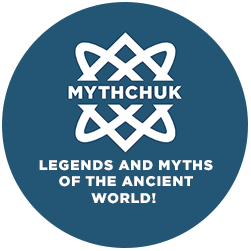The Myth of Oisín in Tír na nÓg — Irish Legend of Time, Love and Lossm
- Main
- >
- Celtic Mythology
- >
- Celtic Myths and Legends
- >
- Oisin in Tir na nOg
This is a story where three years feel like three hundred. You’ll discover what happened to the legend at the end...
The Myth of Oisin in Tir na nOg
The Myth of Oisin in Tir na nOg is one of the most famous Irish tales, originating from the Fianna Cycle (8th–12th centuries AD). Its most complete account is found in Acallam na Senórach and various medieval poetic collections. It tells of a warrior of the Fianna who enters the land of eternal youth—but does not remain there and ultimately returns home.
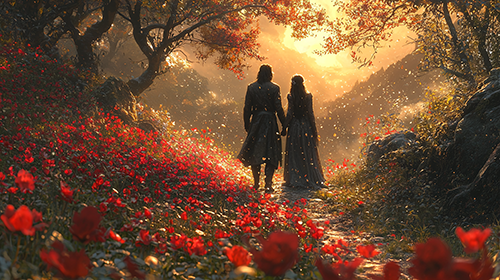 The Myth of Oisin in Tir na nOg
The Myth of Oisin in Tir na nOgOisín — Son of Fionn
Oisín (meaning “little deer”) is the son of the legendary Fionn mac Cumhaill, leader of the Fianna, the elite warrior band of Ireland. He was born during a hunt, when his father was pursuing an enchanted deer thought to be a woman in disguise. This marks his origin as touched by otherworldly magic—he became both warrior and poet, enchanted from childhood.
As he grew, Oisín became one of the greatest heroes of his line. His name became intertwined with myth, song, and ancient poetry—as a symbol of the union of strength and lyricism.
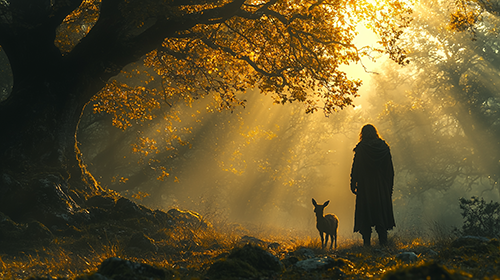 Oisín
OisínMeeting Niamh
One day, while the Fianna were hunting near Lough Leagh, a mysterious woman on a white horse appeared—Niamh Chinn Óir (Niamh of the Golden Hair). She asked Oisín to come with her to Tir na nOg, the Land of Eternal Youth. She was said to be the daughter of the sea god Manannán mac Lir.
Oisín fell in love with her at first sight. He agreed and promised his friends he would return soon. In an instant, a magical white horse, able to ride the sea’s waves, swept them across the ocean to Tir na nOg.
 Meeting Niamh
Meeting NiamhIn Tir na nOg
In Tir na nOg, endless spring reigns—no one ages, no disease touches them, no sorrow disturbs. The Tuatha Dé Danann dwell there—poets, musicians, they celebrate and feast eternally.
Oisín spent three years there—by his own reckoning. But he began to long for home, missing his father and his comrades. When he asked to leave, Niamh gave him the horse Emhair and cautioned:
“Never set foot upon the soil of Ireland—or you will never return.”
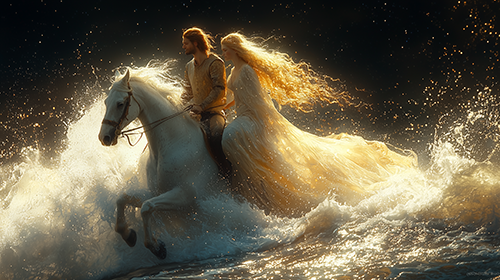 In Tir na nOg
In Tir na nOgReturn and Astonishing Change
Oisín departed, again riding across the sea. He did not age or tire during the journey. But when he reached Ireland’s shores, everything had changed. No one remembered his father or the Fianna—they existed only in legend.
On his way, Oisín saw men struggling to move a great stone. He dismounted to help—leaning down to lift a rock, the horse’s bridle snapped, and he fell to the ground. Immediately, everything shifted: his body bent under the weight of three hundred years, his hair turned white, his hands withered—finally overtaken by the age the magical land had delayed.
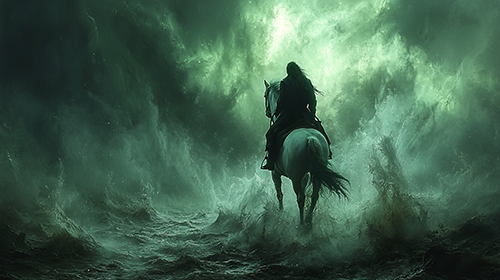 Return and Astonishing Change
Return and Astonishing ChangeEnding and Encounter with Saint Patrick
At that moment, Emhair vanished, returning to Tir na nOg. Oisín, now an old man, anonymous and alone, could not return. In some versions, Saint Patrick found him and taught him Christian prayers. Finally, he died—fading like an old flame—leaving behind a tale of beauty, love, and the tragedy of time.
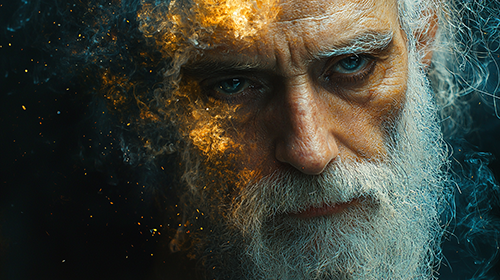 Ending and Encounter with Saint Patrick
Ending and Encounter with Saint PatrickConclusion
The legend of Oisín is a story of escape from time, but not of triumph over it. It shows that even in a world without aging or pain, the ache of separation remains. Ancient Irish storytellers passed on this myth as a testament to loyalty, love, conscience—and as a warning: do not forsake your roots for the sake of a dream.
The tale persists in oral tradition, recorded in Acallam na Senórach, the Book of Leinster, and 17th–18th century poetry. Later, W. B. Yeats’ romantic interpretations revived interest in the legend. Today, it is told as a tale of lost time—reminding us that our roots are most precious.
